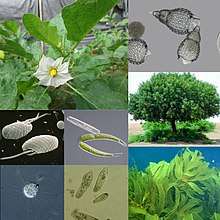Plants+HC+SAR megagroup
The Archaeplastida+HC+SAR megagroup (Archaeplastida comprising the red algae, the green algae, and the land plants) is a group of eukaryotes proposed by Burki et al. (2008).[1]
| Plants+HC+SAR megagroup | |
|---|---|
 | |
| Scientific classification | |
| Domain: | Eukaryota |
| (unranked): | Diaphoretickes |
| unranked groups | |
It includes:
- Archaeplastida (or kingdom Plantae sensu lato)
- Hacrobia (the "HC" refers to Haptista and Cryptista, the two basal clades in the group)
- stramenopiles+alveolates+Rhizaria (SAR supergroup)
This description includes all Bikonts that are not excavates and Hemimastigophora. It is also referred to as Diaphoretickes (/ˌdaɪəfəˈrɛtɪkiːz/) or the SAR/HA Supergroup, or the Corticata with Rhizaria now included in the SAR supergroup.[2]
It was previously described as the sum of Archaeplastida, Rhizaria, and chromalveolates.[3] However, this description is obsolete, largely due to the discovery that chromalveolata was not monophyletic.
It includes most of the species engaging in photosynthesis, except for the Euglenozoa and Cyanobacteria.
References
- Burki, F.; Shalchian-Tabrizi, K.; Pawlowski, J. (2008). "Phylogenomics reveals a new 'megagroup' including most photosynthetic eukaryotes". Biology Letters. 4 (4): 366–369. doi:10.1098/rsbl.2008.0224. PMC 2610160. PMID 18522922.
- Thomas Cavalier-Smith, Ema E. Chao, Elizabeth A. Snell, Cédric Berney, Anna Maria Fiore-Donno, and Rhodri Lewis. 2014. "Multigene eukaryote phylogeny reveals the likely protozoan ancestors of opisthokonts (animals, fungi, choanozoans) and Amoebozoa". Molecular Phylogenetics and Evolution 81:71–85. doi:10.1016/j.ympev.2014.08.012
- Hampl, V.; Hug, L.; Leigh, J.; Dacks, J.; Lang, B.; Simpson, A.; Roger, A. (2009). "Phylogenomic analyses support the monophyly of Excavata and resolve relationships among eukaryotic "supergroups"". Proceedings of the National Academy of Sciences of the United States of America. 106 (10): 3859–3864. Bibcode:2009PNAS..106.3859H. doi:10.1073/pnas.0807880106. PMC 2656170. PMID 19237557.
This article is issued from Wikipedia. The text is licensed under Creative Commons - Attribution - Sharealike. Additional terms may apply for the media files.